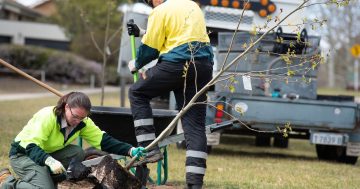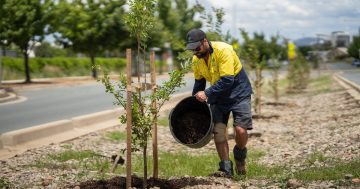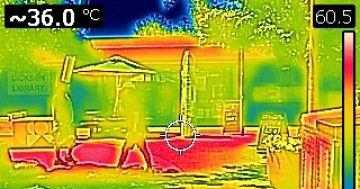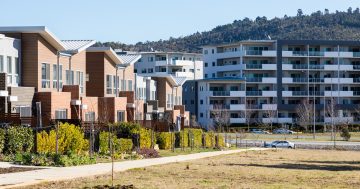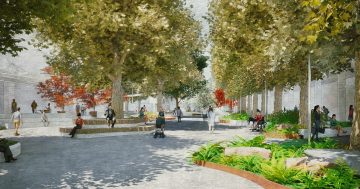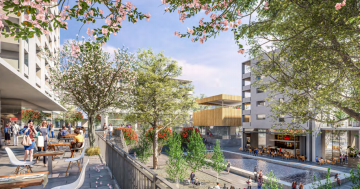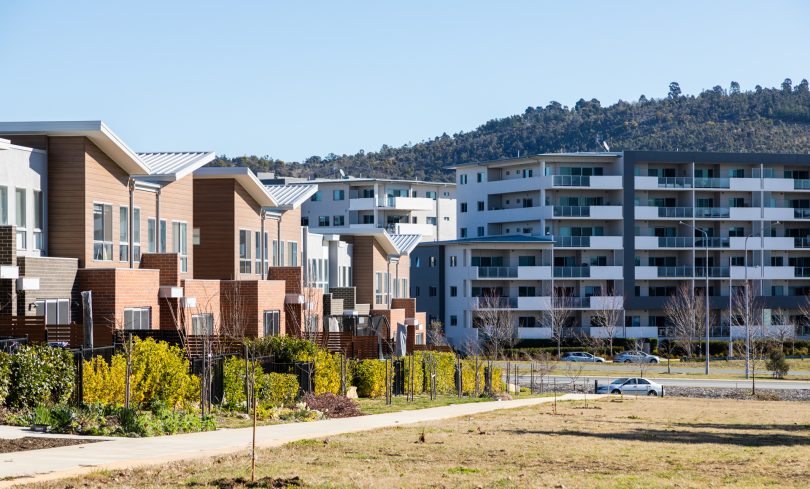
New apartments and townhouses in Coombs. Heat islands without the trees. Photo: Michelle Kroll.
Canberrans love green space and their trees, unless of course they are dropping limbs and litter, or a that extra bedroom or media room means maxing out the block.
Or if they are in the way of extracting as much value as possible from a land release or multi-unit block, or conversely, providing as many dwellings as possible to home buyers.
Either way, the results across new suburbs and old has been the same – a decline in permeable spaces and tree canopy cover, and that spells danger in a changing climate, and for the long-term sustainability of those areas.
Which is why Draft Variation 369, back from consultation and now ready to go to a Legislative Assembly committee, will be a good thing for Canberra’s neighbourhoods, whether they be in leafy Griffith or the developing suburbs of Gungahlin and Molonglo.
The planning mechanism by which the Living Infrastructure Plan, to give the city 30 per cent tree canopy cover and 30 per cent permeable spaces by 2045, is to be implemented is long overdue because in some areas Canberra has lost its way.
There are suburbs, particularly in Gungahlin, that should never have been developed the way they were, and the trend for knock down rebuilds and dual occupancies in established areas has degraded neighbourhoods where plot ratios have been so unbalanced that little room has been left for trees or a garden.
Some suburbs have rows of houses on small blocks that may as well be terraces, so close are the walls.
There are a lot of factors leading to this overdevelopment, the price of land being one, but the practical consequences are felt in the loss of amenity and the sheer heat that can be generated by massed buildings without enough vegetation to provide any cooling effects let alone the aesthetics of a bit of greenery.
This is a public health issue and one for the pocket too when the energy bills arrive.
It is to successive Labor governments’ shame that they have allowed the situation to go on year after year, and to the Greens’ credit that they have advocated and appeared to have achieved proposed changes to the Territory Plan that will help the ACT avoid heat island effects and wasteful and destructive stormwater run-off.
Some may argue the proposed changes don’t go far enough, and sections of the property industry will no doubt continue their lobbying against them, arguing that they will just push up the cost of housing.
Well, some industry lobbyists haven’t been too concerned about the generous tax settings and grants combined with cheap money that has had more impact on house prices than planning rules.
The increase to 20 per cent from 15 per cent tree canopy cover for multi-unit developments is welcome, because they have the greatest potential to become heat islands, and residents deserve all the natural amenity they can get.
What developers – and that goes for government too – builders and architects must do is respond with innovative design that uses space more efficiently and factor in the future cost savings that trees and gardens can bring.
Some are already doing that, although at least one builder I have spoken to says convincing clients that less can be more takes a bit of effort.
Home owners should realise that their patch of dirt is not completely independent of its surroundings, and there is a responsibility to respect the surrounding environment that was probably one reason for buying where they did.
The future must be green – for public health, to maintain the character of neighbourhoods, to prevent flash flooding and for creating urban development that is livable, for the human beings who inhabit it.
It is basically good planning, something that has been in short supply.













